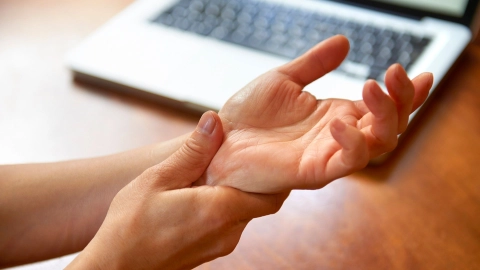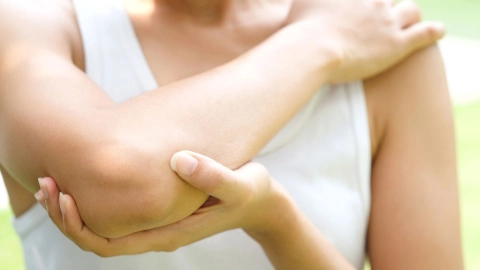Conditions Tennis elbow
ICD codes: M77.1 What are ICD codes?
Tennis elbow is usually caused by repetitive movements or too much strain – for instance, during sports or when doing manual labor. A typical symptom is pain in the outer elbow.
At a glance
- Tennis elbow is usually caused by repetitive movements or too much strain.
- A typical symptom is pain in the outer elbow.
- Around 2 out of every 100 people have tennis elbow.
- Tennis elbow typically requires a bit of patience, as it often takes a few months for the symptoms to clear up.
- Treatments can relieve the pain somewhat or speed up recovery.
Note: The information in this article cannot and should not replace a medical consultation and must not be used for self-diagnosis or treatment.

What is tennis elbow?
Tennis elbow is usually caused by repetitive movements or too much strain. This kind of strain is experienced for instance during sports like tennis or when doing manual labor. A typical symptom of tennis elbow is pain in the outer elbow. However, it may also spread over the entire arm.
Tennis elbow often requires a bit of patience, as it can take a few months for the symptoms to clear up. Various treatments can relieve the pain somewhat or speed up the recovery process. But for many treatments their effectiveness is not proven.
What are the symptoms of tennis elbow?
The typical pain in the outer elbow is mostly only felt when the elbow is moved or touched. It may spread into the upper arm, forearm or the hand. Even the simplest movements can be painful, like unscrewing the cap of a bottle. If the symptoms are severe, just lifting up a cup of coffee can be a problem.
With tennis elbow, it also becomes difficult to get a strong grip, and the arm is often less flexible than it was before. These symptoms can also occur at night and make it hard to sleep. The pain sometimes goes away when the arm is resting.
What causes tennis elbow?
In tennis elbow, the pain arises where the tendons attach to muscles on the outside of the elbow. These tendons are involved in movements that extend the wrist. For this reason, hand and arm movements that put a strain on them – such as bending, stretching, twisting – can lead to the typical symptoms. These include grasping and lifting movements.
It often affects people who usually don’t use their forearm muscles much, and then suddenly overuse them. But the symptoms don’t only result from short-term overuse. Regular repetitive strain can also result in tennis elbow.
Possible causes include:
- sports like tennis, rowing or strength training
- manual labor like painting, carpentry or turning screws
- heavy lifting
- playing musical instruments, such as the piano
- working at a computer or a supermarket cash register
So although tennis elbow can actually be caused by playing tennis, it usually has nothing to do with this sport.
Doctors used to think that the pain was caused by an inflammation in the muscles. However, tennis elbow probably arises from the overuse or incorrect use of muscles, which leads to small injuries and wear and tear at the base of the tendons that attach to the muscles. But it’s not exactly known yet what causes tennis elbow.
How common is tennis elbow?
Around 2 out of every 100 people have tennis elbow. It is most common in those aged between 40 and 60. This is probably because the muscles are more susceptible to overuse at this age. Tennis elbow is equally common in men and women.
How does tennis elbow develop?
Sometimes the symptoms go away after just a few weeks, but they often last several months. In about 80% of people who develop tennis elbow, the pain goes away within one year. The others continue to have symptoms for longer.
How is tennis elbow diagnosed?
To diagnose tennis elbow, the doctor will first ask the person affected what sort of activities make the pain noticeable and whether they have any other medical conditions. Then they will examine their arm and check what movements trigger the pain. This might involve extending their arm with the palm of their hand facing down, and then pressing the same hand upwards against a certain amount of resistance. If that makes the person’s elbow hurt, it’s a sign of tennis elbow.
A physical examination is usually enough to find out whether a person has tennis elbow. X-rays, ultrasound scans or MRI (magnetic resonance imaging) are only considered if doctors think that the symptoms may have a different cause.
How is tennis elbow treated?
The goal of treatment is to relieve the pain and to improve the mobility and strength of the arm and wrist.
Trying to avoid activities that provoke the symptoms – or reducing those activities enough to make the symptoms improve – may already help. Special exercises to strengthen the forearm and wrist, called “eccentric exercises”, can help to relieve the pain. Manual therapy from a physiotherapist can help too.
For more detailed information, for example about strengthening and stretching exercises for tennis elbow, visit gesundheitsinformation.de.
Doctors often use very different approaches to treat tennis elbow. But only a few of these treatments have been proven to be able to relieve the symptoms. First and foremost, tennis elbow requires patience, as the symptoms usually clear up after a few months without any special treatment.
Non-steroidal anti-inflammatory drugs (NSAIDs) can provide short-term relief. Cortisone injections can also relieve pain, but they may disrupt the healing process. A few studies suggest that ultrasound therapy can somewhat improve the pain.
There is no proof that the following treatments help:
- various injection treatments, for example, with blood taken from your own body or with Botox
- laser therapy
- electrotherapy
- massage
- shockwave therapy
- acupuncture
German statutory health insurers often don't cover the costs of these treatments. If the symptoms continue for a long time and other treatments don’t help, surgery is sometimes suggested. There has hardly been any research on the usefulness of tennis elbow surgery, though.
- Ahmad Z, Siddiqui N, Malik SS et al. Lateral epicondylitis: A review of pathology and management. Bone Joint J 2013. 95-B (9): 1158-1164. doi: 10.1302/0301-620X.95B9.29285.
- Bisset L, Coombes B, Vicenzino B. Tennis elbow. BMJ Clin Evid 2011; 1117.
- Buchbinder R, Johnston RV, Barnsley L et al. Surgery for lateral elbow pain. Cochrane Database Syst Rev 2011; (3): CD003525. doi: 10.1002/14651858.CD003525.pub2.
- Dingemanse R, Randsdorp M, Koes BW, Huisstede BM. Evidence for the effectiveness of electrophysical modalities for treatment of medial and lateral epicondylitis: a systematic review. Br J Sports Med 2014; 48(12): 957-965. doi: 10.1136/bjsports-2012-091513.
- Dong W, Goost H, Lin XB et al. Injection therapies for lateral epicondylalgia: a systematic review and Bayesian network meta-analysis. Br J Sports Med 2016; 50(15): 900-908. doi: 10.1136/bjsports-2014-094387.
- Loew LM, Brosseau L, Tugwell P et al. Deep transverse friction massage for treating lateral elbow or lateral knee tendinitis. Cochrane Database Syst Rev 2014; (11): CD003528. doi: 10.1002/14651858.CD003528.pub2.
- Mattie R, Wong J, McCormick Z et al. Percutaneous Needle Tenotomy for the Treatment of Lateral Epicondylitis: A Systematic Review of the Literature. PM R 2017; 9(6): 603-611. doi: 10.1016/j.pmrj.2016.10.012.
- Orchard J, Kountouris A. The management of tennis elbow. BMJ 2011; 342: d2687. doi: 10.1136/bmj.d2687.
- Raman J, MacDermid JC, Grewal R. Effectiveness of different methods of resistance exercises in lateral epicondylosis - a systematic review. J Hand Ther 2012; 25(1): 5-25; quiz 26. doi: 10.1016/j.jht.2011.09.001.
- Tang H, Fan H, Chen J et al. Acupuncture for Lateral Epicondylitis: A Systematic Review. Evid Based Complement Alternat Med 2015: 861849. doi: 10.1155/2015/861849.
In cooperation with the Institute for Quality and Efficiency in Health Care (Institut für Qualität und Wirtschaftlichkeit im Gesundheitswesen) (IQWiG).
As at:





